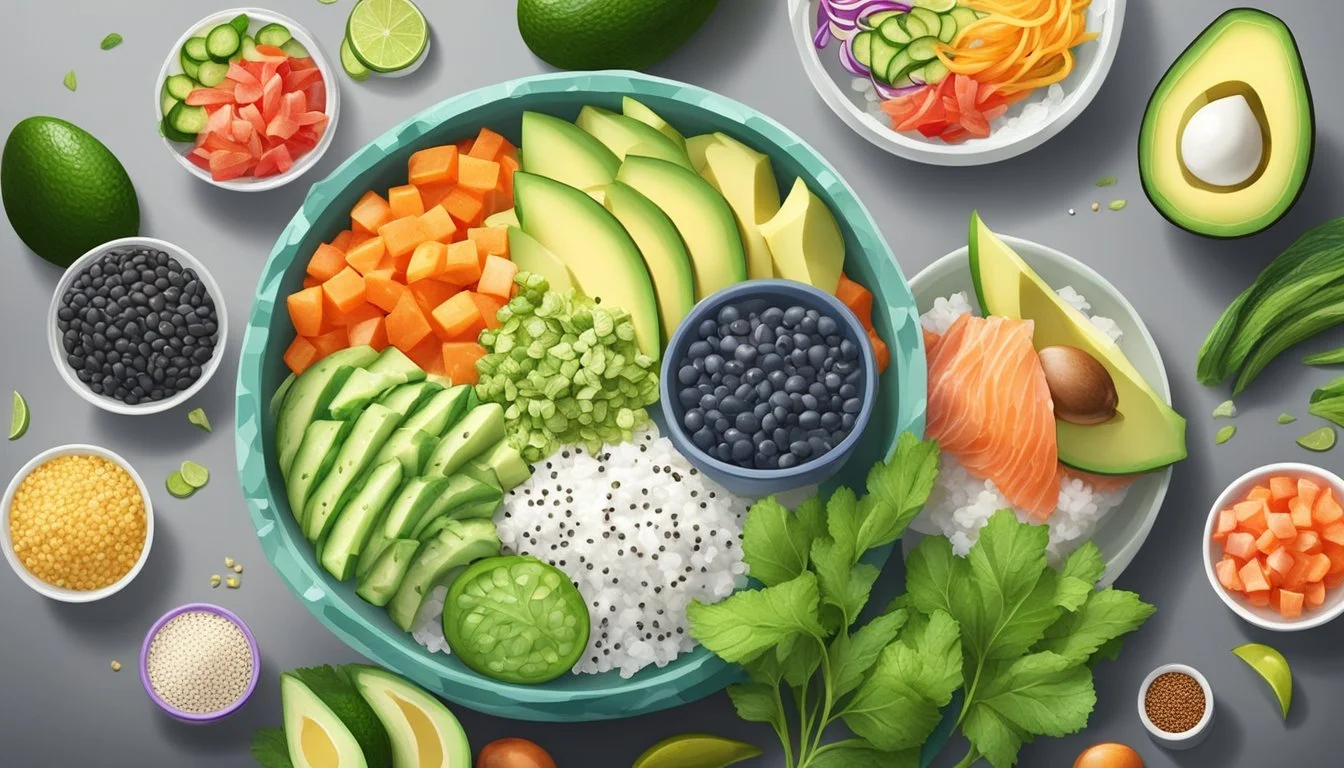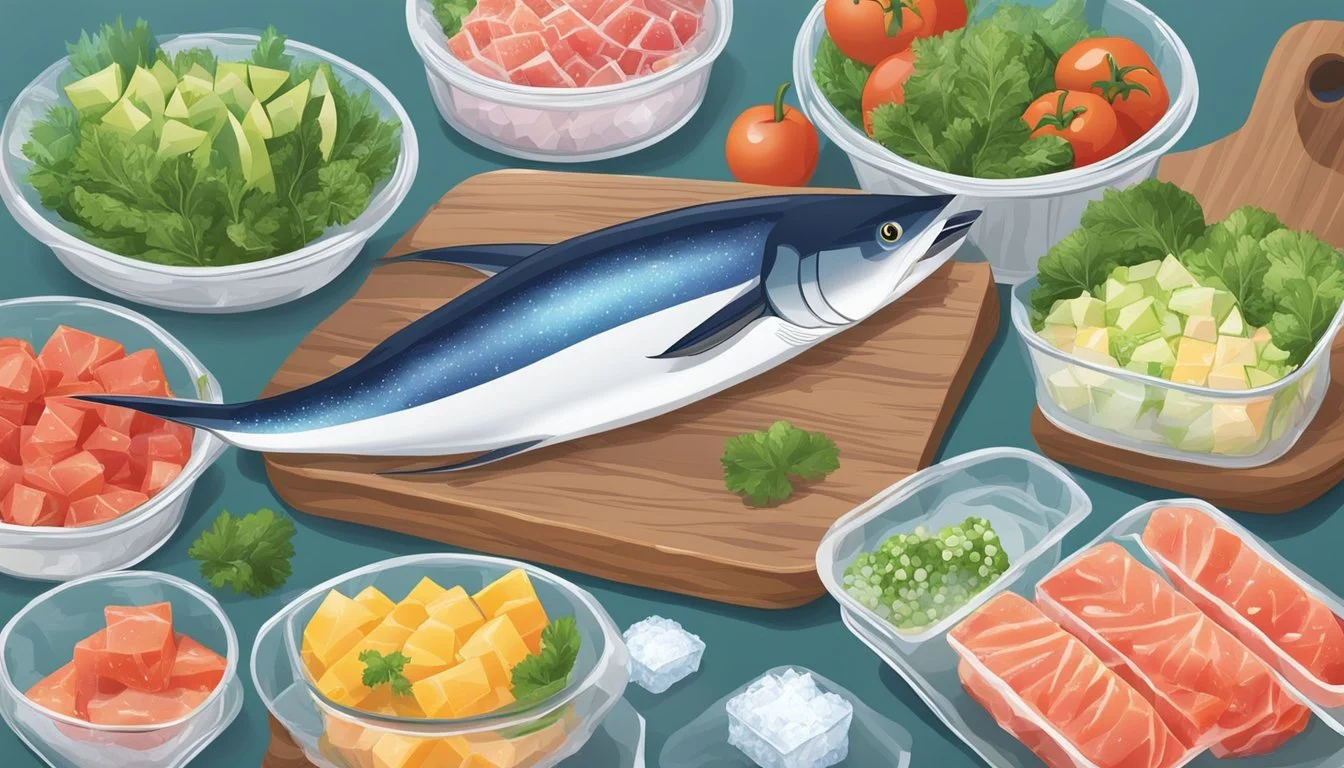Fresh vs Frozen Poke: Comparing Quality, Taste, and Safety
Poke, the beloved Hawaiian dish featuring cubed raw fish, has gained popularity worldwide. Traditionally made with fresh tuna, modern variations now include frozen options. The choice between fresh and frozen poke can significantly impact flavor, texture, and overall quality.
Many poke enthusiasts argue that fresh tuna provides the best taste experience. Fresh fish offers a delicate texture and clean flavor that truly captures the essence of Hawaiian cuisine. However, frozen poke has become increasingly common, especially in locations far from coastal areas. Freezing technology has improved, allowing for better preservation of taste and texture.
When selecting poke, consider factors such as availability, cost, and intended use. Fresh poke shines in its pure form, while frozen options work well in cooked recipes or heavily seasoned preparations. Both types can deliver delicious results when prepared properly, allowing people everywhere to enjoy this Japanese-influenced Hawaiian delicacy.
Origins and Popularity
Poke traces its roots to ancient Hawaii. Native Hawaiians created this dish using freshly caught fish, sea salt, seaweed, and crushed kukui nuts.
The word "poke" means "to slice or cut" in Hawaiian. Originally, fishermen would slice their catch and season it as a snack.
Poke evolved over time, incorporating Japanese influences after their immigration to Hawaii in the late 1800s. This fusion led to the addition of soy sauce and other Japanese ingredients.
Traditional poke uses raw ahi tuna or octopus. However, modern versions include salmon, tofu, and various other proteins.
The dish gained widespread popularity in the 2010s, spreading from Hawaii to the mainland United States and beyond. Social media platforms like Instagram and Facebook played a significant role in its rise to fame.
Poke bowls became a trendy food item, with restaurants and food trucks specializing in this Hawaiian staple popping up across the globe.
The customizable nature of poke bowls contributed to their popularity. Diners can choose their base, protein, and toppings, creating a personalized meal.
Poke's appeal lies in its combination of fresh ingredients, bold flavors, and perceived healthiness. It represents a fusion of traditional Hawaiian cuisine with modern culinary trends.
Understanding Poke
Poke is a traditional Hawaiian dish featuring cubed raw fish marinated in flavorful sauces and seasonings. It combines fresh seafood with savory ingredients for a unique culinary experience.
Defining Poke
Poke, pronounced "poh-keh," means "to slice or cut" in Hawaiian. This dish consists of bite-sized pieces of raw fish, typically tuna, mixed with various seasonings. The fish is cut into cubes and marinated, creating a harmonious blend of textures and flavors.
Poke has evolved from its traditional roots to include a wide variety of ingredients and styles. While tuna remains a popular choice, other fish like salmon or octopus can also be used. The dish often incorporates a mix of Asian and Hawaiian flavors, reflecting the diverse cultural influences in Hawaiian cuisine.
Traditional Ingredients
Classic poke recipes feature a core set of ingredients that provide its distinctive taste and texture. The main component is raw fish, usually ahi tuna, cut into small cubes. Soy sauce and sesame oil form the base of the marinade, imparting umami and richness to the dish.
Onions, both regular and green varieties, add a sharp, fresh flavor and crunchy texture. Seaweed, often in the form of limu (a type of edible algae), contributes a briny taste and chewy consistency. Sesame seeds are commonly sprinkled on top for added nutty flavor and visual appeal.
Other traditional mix-ins may include:
Sea salt
Chili pepper
Crushed kukui nut (candlenut)
Seaweed flakes
These ingredients work together to create a balanced, flavorful dish that showcases the quality of the fish while complementing it with bold, aromatic additions.
Fresh Poke
Fresh poke offers unparalleled quality and flavor. It showcases the natural taste and texture of raw fish, typically sourced from local waters and prepared with care.
Benefits of Fresh Poke
Fresh poke delivers superior taste and texture compared to frozen alternatives. The fish retains its natural moisture and firmness, resulting in a more enjoyable eating experience. Fresh poke also preserves delicate flavors that can be lost during freezing. Nutritionally, fresh fish often contains higher levels of beneficial omega-3 fatty acids.
Fresh poke allows for greater customization. Chefs can tailor cuts and seasonings to highlight the unique qualities of each fish. This versatility enables the creation of innovative flavor combinations and textures.
Selecting Fresh Ingredients
When choosing fish for fresh poke, look for bright, clear eyes and shiny, firm flesh without any discoloration. The fish should have a mild, ocean-like scent without any strong odors. Ahi tuna, yellowfin tuna, and salmon are popular choices for poke.
For optimal freshness, select sushi-grade or sashimi-grade fish. These designations indicate the fish has been handled and stored properly for raw consumption. Reputable seafood markets and specialty grocers often carry these high-quality options.
Sourcing Fresh Fish
To ensure the best quality, source fresh fish from trusted suppliers. Local seafood markets often offer the freshest options, as they receive daily deliveries from nearby fishing boats. Some grocery stores also carry fresh, sushi-grade fish suitable for poke.
When possible, buy fish caught using sustainable methods. This helps preserve fish populations and marine ecosystems. Ask your fishmonger about the origin and catch method of the fish.
For landlocked areas, consider overnight shipping from coastal suppliers. Many companies specialize in delivering fresh, sushi-grade fish packed on ice to maintain quality during transit.
Frozen Poke
Frozen poke offers a practical alternative to fresh poke, with some distinct advantages and considerations. It provides extended shelf life and wider availability for consumers beyond coastal areas.
Advantages of Frozen Poke
Frozen poke significantly extends the shelf life of the product. This allows retailers to stock poke for longer periods, reducing waste and potentially lowering costs for consumers.
Freezing also enables wider distribution of poke to areas far from coastal regions. Inland grocery stores can now offer this Hawaiian dish to customers who might otherwise lack access to fresh seafood.
Frozen poke is often more affordable than its fresh counterpart. The ability to buy in bulk and store for extended periods can lead to cost savings for both businesses and consumers.
Quality and Convenience
The quality of frozen poke largely depends on the freezing process and handling. Many suppliers use rapid freezing techniques to preserve the texture and flavor of the fish.
Frozen poke offers convenience for home cooks. It can be stored in the freezer for several months, allowing for spontaneous poke bowl preparation without frequent trips to the store.
Some frozen poke products are treated with carbon monoxide to maintain color. While this practice is FDA-approved, it's important for consumers to be aware of the treatment.
Thawing frozen poke properly is crucial for maintaining quality. Gradual thawing in the refrigerator is recommended to preserve texture and minimize moisture loss.
Poke Bowls at Home
Creating poke bowls at home allows for customization and fresh ingredients. This Hawaiian-inspired dish combines marinated fish, rice, and various toppings for a delicious and healthy meal.
Essential Components of a Poke Bowl
The foundation of a poke bowl is high-quality raw fish, typically ahi tuna. Cut the fish into 1/2-inch cubes for easy eating. Choose sushi-grade fish to ensure safety and quality.
Rice forms the base of the bowl. Sushi rice is traditional, but brown rice or cauliflower rice offer healthier alternatives. Cook the rice in advance and let it cool to room temperature.
A flavorful marinade enhances the fish. Combine soy sauce, sesame oil, rice vinegar, and ginger for a classic taste. Marinate the fish for 15 minutes to 1 hour before serving.
Toppings add texture and nutrition. Popular choices include:
Cucumber
Seaweed salad
Edamame
Pickled vegetables
Furikake seasoning
Crafting the Perfect Bowl
Start by placing a scoop of rice in the bowl. Arrange the marinated fish on top of the rice. Add toppings in sections around the fish for visual appeal.
Drizzle with additional sauce if desired. Sriracha aioli adds a spicy kick. Mix mayonnaise, sriracha, and a squeeze of lime juice for an easy homemade version.
Garnish with sesame seeds and chopped green onions. These add flavor and visual interest to the finished bowl.
Balance flavors and textures. Combine crunchy elements like cucumber with creamy avocado. Mix sweet, salty, and spicy components for a well-rounded taste.
Home Preparation Tips
Prep ingredients in advance for quick assembly. Cook rice, chop vegetables, and mix sauces ahead of time. Store components separately in the refrigerator.
Use a sharp knife to cut fish cleanly. This prevents tearing and ensures attractive cubes. Pat the fish dry before cutting to make handling easier.
Customize bowls to personal preferences. Experiment with different fish like salmon or hamachi. Try vegetarian options using tofu or edamame as the protein.
Serve poke bowls immediately after assembly. The freshness of ingredients is key to the dish's appeal. If preparing for later, keep components separate until ready to eat.
Flavor Profile and Seasonings
Poke's flavor profile relies on a blend of traditional seasonings and modern twists. The right combination of ingredients enhances the taste of fresh or frozen fish, creating a delicious and balanced dish.
Classic Seasonings
Soy sauce forms the foundation of most poke marinades, providing a salty umami base. Sesame oil adds a nutty richness, while diced onions and green onions contribute crunch and sharpness. Seaweed flakes bring a briny ocean flavor. Sesame seeds offer texture and a subtle nuttiness.
For heat, red pepper flakes are often sprinkled in. Some recipes use shoyu, a Japanese-style soy sauce, for a milder taste. Rice vinegar can add a tangy note to balance the flavors.
Many chefs marinate the fish for 30 minutes to 2 hours before serving, allowing the flavors to meld.
Modern Twists
Contemporary poke bowls incorporate new flavors to appeal to diverse palates. Wasabi provides a fiery kick, while sriracha sauce adds a garlicky heat. Spicy mayo, made by mixing sriracha and mayonnaise, is a popular creamy topping.
Some chefs experiment with fruit-based sauces or citrus juices for a bright, acidic contrast. Ponzu, a citrus-soy blend, is gaining popularity as a lighter alternative to traditional soy-based marinades.
Herbs like cilantro or Thai basil can add fresh, aromatic notes. Pickled vegetables, such as daikon radish, introduce tangy crunch and complexity to the dish.
Nutritional Information
Poke bowls offer a nutritious meal option with a balance of proteins, fats, and carbohydrates. The main protein source, typically raw fish, provides high-quality lean protein and omega-3 fatty acids.
Fresh fish in poke delivers essential nutrients like vitamin D, selenium, and iodine. Frozen fish can retain similar nutritional value if processed and stored properly.
A standard poke bowl contains approximately:
400-600 calories
20-30g protein
15-25g fat
40-60g carbohydrates
The exact nutritional content varies based on ingredients and portion sizes. Base choices like brown rice or mixed greens can impact the overall nutritional profile.
Vegetables in poke bowls contribute vital vitamins, minerals, and fiber. Fresh vegetables may have slightly higher vitamin C content compared to frozen alternatives.
Toppings and sauces can significantly affect calorie and sodium levels. Soy sauce and sesame oil, common in poke, are calorie-dense and high in sodium.
For those concerned about raw fish consumption, properly frozen fish can reduce the risk of foodborne illnesses while maintaining nutritional benefits.
Cultural Variations
Poke's journey from traditional Hawaiian dish to global sensation has led to diverse interpretations across cultures. These variations reflect local tastes and ingredient availability while maintaining the essence of the original concept.
Hawaiian Poke
Traditional Hawaiian poke centers on raw ahi tuna or octopus. The fish is cubed and seasoned with sea salt, limu (seaweed), and crushed kukui nuts. Green onions and sweet Maui onions often add crunch and flavor.
On the islands, poke is commonly served as a standalone dish or over rice. Local variations may include yellowfin tuna, macadamia nuts, or garlic for added depth. Each Hawaiian island brings its own twist to poke, with Maui's preparation featuring the island's famous sweet onions.
Fresh, locally-caught fish is paramount in authentic Hawaiian poke. The dish embodies the islands' connection to the sea and their rich culinary heritage.
Japanese Influence
Japanese culinary traditions have significantly shaped modern poke. The influx of Japanese immigrants to Hawaii in the early 1900s introduced new flavors and techniques.
Sashimi-grade fish became a staple in poke preparations, elevating the dish's quality. Japanese seasonings like soy sauce, wasabi, and furikake found their way into poke recipes. These additions complemented the traditional Hawaiian ingredients.
The Japanese concept of donburi - rice bowls topped with various ingredients - influenced the popular poke bowl format. This fusion created a more substantial meal that appealed to a wider audience.
Global Interpretations
As poke gained international popularity, it adapted to local palates and ingredient availability. In the mainland United States, poke bowls often feature a wider variety of toppings and sauces.
European interpretations might incorporate local fish varieties or add Mediterranean elements. In Southeast Asian countries like the Philippines and Indonesia, poke may be infused with regional spices and served with tropical fruits.
Some global variations stray far from traditional poke, using cooked proteins or vegetarian options. While purists may debate their authenticity, these adaptations have helped spread poke's popularity worldwide.
Frozen fish is more common in regions far from coastlines, allowing for year-round poke availability. However, this can impact the texture and flavor compared to fresh fish preparations.
Food Safety and Storage
Proper handling and storage of poke are crucial for maintaining its quality and safety. Following recommended practices helps prevent foodborne illness and ensures the dish remains fresh and delicious.
Handling Raw Fish
When preparing poke, use sashimi-grade fish from reputable sources. Wash hands thoroughly before and after handling raw fish. Keep the fish refrigerated at 40°F (4°C) or below until ready to use. Use separate cutting boards and utensils for raw fish to prevent cross-contamination. Clean and sanitize all surfaces and equipment after use.
Thaw frozen fish in the refrigerator, not at room temperature. Once thawed, consume within 24 hours. Never refreeze raw fish that has been thawed.
Storing Poke
Store fresh poke in airtight containers in the refrigerator at 40°F (4°C) or below. Consume within 1-2 days for optimal freshness and safety. Keep poke separate from other foods to prevent cross-contamination.
For longer storage, freeze poke immediately after preparation. Use freezer-safe containers or vacuum-sealed bags. Frozen poke can last up to 3 months when stored at 0°F (-18°C) or below.
When to Consume
Consume fresh poke within 24 hours of preparation for the best quality and safety. If refrigerated promptly, it may remain safe for up to 2 days, but quality may decline.
Frozen poke should be consumed within 3 months for optimal taste and texture. Once thawed, eat within 24 hours and do not refreeze.
Discard poke if it has a sour smell, slimy texture, or discoloration. When in doubt, throw it out to avoid potential foodborne illness.






